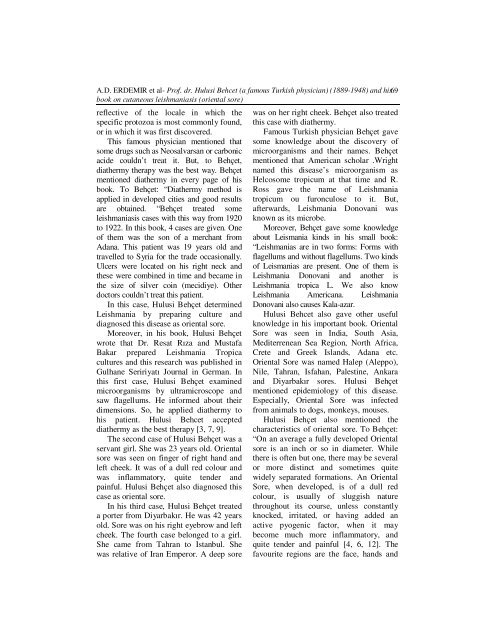Series VI: Medical Sciences – SUPPLEMENT ... - Krongres
Series VI: Medical Sciences – SUPPLEMENT ... - Krongres
Series VI: Medical Sciences – SUPPLEMENT ... - Krongres
Create successful ePaper yourself
Turn your PDF publications into a flip-book with our unique Google optimized e-Paper software.
A.D. ERDEMIR et al- Prof. dr. Hulusi Behcet (a famous Turkish physician) (1889-1948) and his 69<br />
book on cutaneous leishmaniasis (oriental sore)<br />
reflective of the locale in which the<br />
specific protozoa is most commonly found,<br />
or in which it was first discovered.<br />
This famous physician mentioned that<br />
some drugs such as Neosalvarsan or carbonic<br />
acide couldn’t treat it. But, to Behçet,<br />
diathermy therapy was the best way. Behçet<br />
mentioned diathermy in every page of his<br />
book. To Behçet: “Diathermy method is<br />
applied in developed cities and good results<br />
are obtained. “Behçet treated some<br />
leishmaniasis cases with this way from 1920<br />
to 1922. In this book, 4 cases are given. One<br />
of them was the son of a merchant from<br />
Adana. This patient was 19 years old and<br />
travelled to Syria for the trade occasionally.<br />
Ulcers were located on his right neck and<br />
these were combined in time and became in<br />
the size of silver coin (mecidiye). Other<br />
doctors couldn’t treat this patient.<br />
In this case, Hulusi Behçet determined<br />
Leishmania by preparing culture and<br />
diagnosed this disease as oriental sore.<br />
Moreover, in his book, Hulusi Behçet<br />
wrote that Dr. Resat Rıza and Mustafa<br />
Bakar prepared Leishmania Tropica<br />
cultures and this research was published in<br />
Gulhane Seririyatı Journal in German. In<br />
this first case, Hulusi Behçet examined<br />
microorganisms by ultramicroscope and<br />
saw flagellums. He informed about their<br />
dimensions. So, he applied diathermy to<br />
his patient. Hulusi Behcet accepted<br />
diathermy as the best therapy [3, 7, 9].<br />
The second case of Hulusi Behçet was a<br />
servant girl. She was 23 years old. Oriental<br />
sore was seen on finger of right hand and<br />
left cheek. It was of a dull red colour and<br />
was inflammatory, quite tender and<br />
painful. Hulusi Behçet also diagnosed this<br />
case as oriental sore.<br />
In his third case, Hulusi Behçet treated<br />
a porter from Diyarbakır. He was 42 years<br />
old. Sore was on his right eyebrow and left<br />
cheek. The fourth case belonged to a girl.<br />
She came from Tahran to Istanbul. She<br />
was relative of Iran Emperor. A deep sore<br />
was on her right cheek. Behçet also treated<br />
this case with diathermy.<br />
Famous Turkish physician Behçet gave<br />
some knowledge about the discovery of<br />
microorganisms and their names. Behçet<br />
mentioned that American scholar .Wright<br />
named this disease’s microorganism as<br />
Helcosome tropicum at that time and R.<br />
Ross gave the name of Leishmania<br />
tropicum ou furonculose to it. But,<br />
afterwards, Leishmania Donovani was<br />
known as its microbe.<br />
Moreover, Behçet gave some knowledge<br />
about Leismania kinds in his small book:<br />
“Leishmanias are in two forms: Forms with<br />
flagellums and without flagellums. Two kinds<br />
of Leismanias are present. One of them is<br />
Leishmania Donovani and another is<br />
Leishmania tropica L. We also know<br />
Leishmania Americana. Leishmania<br />
Donovani also causes Kala-azar.<br />
Hulusi Behcet also gave other useful<br />
knowledge in his important book. Oriental<br />
Sore was seen in India, South Asia,<br />
Mediterrenean Sea Region, North Africa,<br />
Crete and Greek Islands, Adana etc.<br />
Oriental Sore was named Halep (Aleppo),<br />
Nile, Tahran, Isfahan, Palestine, Ankara<br />
and Diyarbakır sores. Hulusi Behçet<br />
mentioned epidemiology of this disease.<br />
Especially, Oriental Sore was infected<br />
from animals to dogs, monkeys, mouses.<br />
Hulusi Behçet also mentioned the<br />
characteristics of oriental sore. To Behçet:<br />
“On an average a fully developed Oriental<br />
sore is an inch or so in diameter. While<br />
there is often but one, there may be several<br />
or more distinct and sometimes quite<br />
widely separated formations. An Oriental<br />
Sore, when developed, is of a dull red<br />
colour, is usually of sluggish nature<br />
throughout its course, unless constantly<br />
knocked, irritated, or having added an<br />
active pyogenic factor, when it may<br />
become much more inflammatory, and<br />
quite tender and painful [4, 6, 12]. The<br />
favourite regions are the face, hands and


